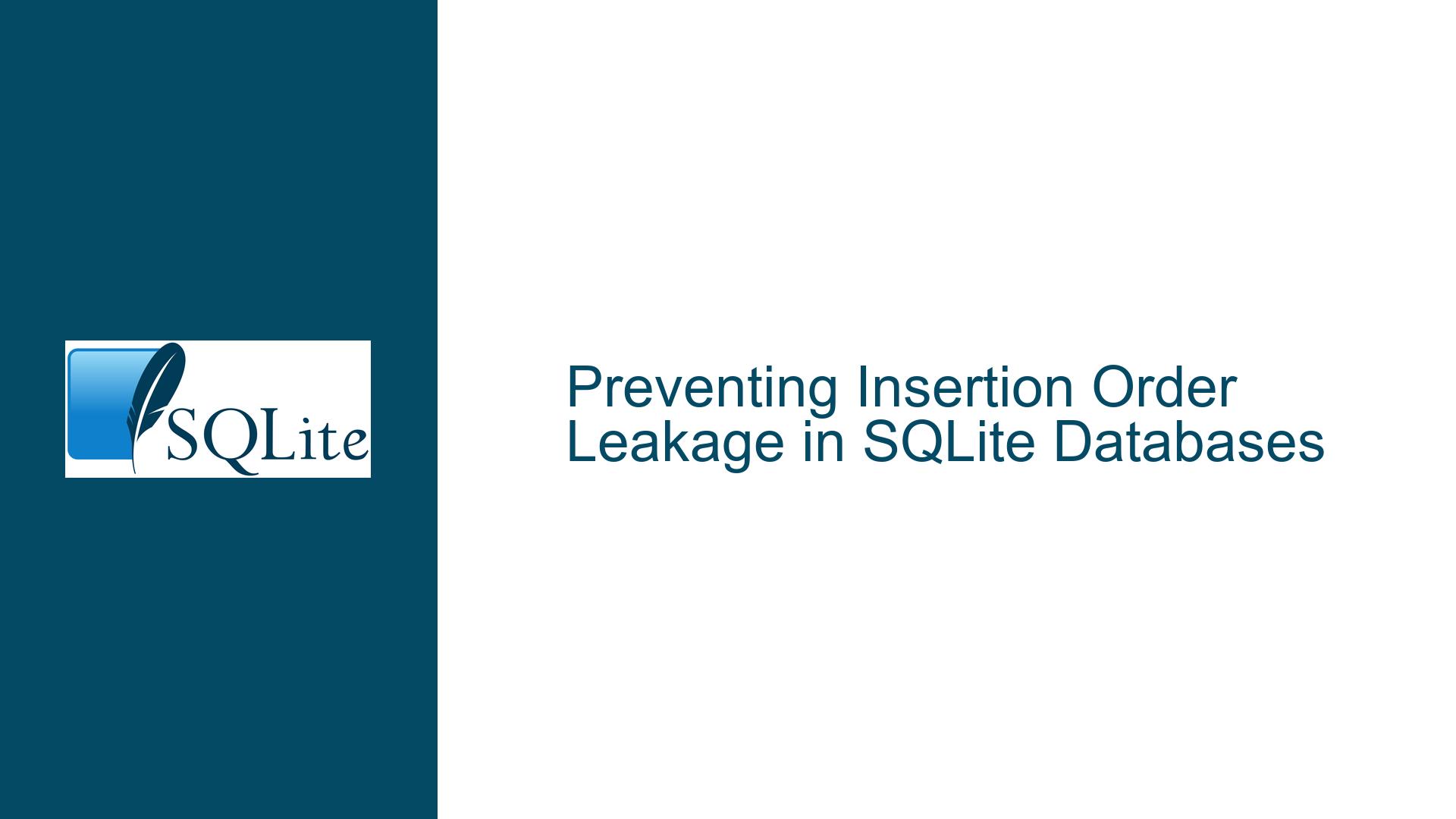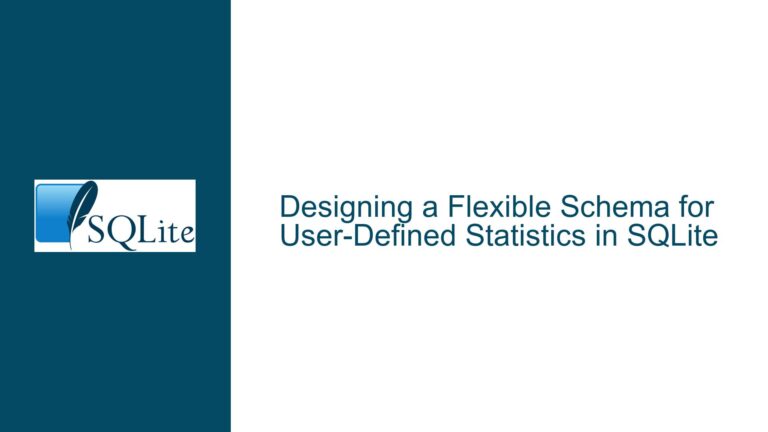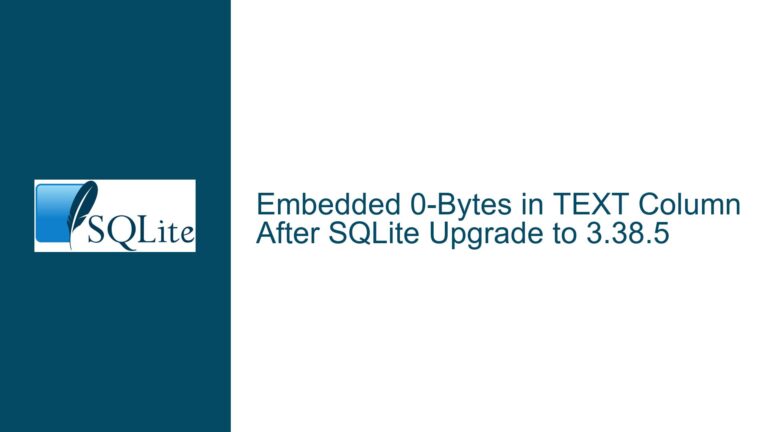Preventing Insertion Order Leakage in SQLite Databases
SQLite Metadata and Insertion Order Leakage Risks
When working with SQLite databases, one of the lesser-discussed but critical concerns is the potential leakage of insertion order metadata. This issue arises when sensitive information about the sequence in which rows were added to a table can be inferred, either through direct access to the database file or via SQL queries. Understanding the nuances of how SQLite handles row storage and metadata is essential for developers who need to ensure data privacy and security.
SQLite, by design, does not store explicit metadata about the insertion order of rows. However, certain structural aspects of the database file and the behavior of the SQLite engine can inadvertently reveal clues about the order in which data was inserted. This can be particularly problematic in scenarios where the insertion order itself is sensitive information, such as in time-series data or logs.
The primary concern is that while SQLite does not maintain a direct record of insertion order, the physical arrangement of data within the database file can sometimes be used to infer this information. For instance, when rows are inserted, they are stored in the order of their rowids, which are typically auto-incremented integers. If an attacker gains access to the raw database file, they might be able to analyze the file’s binary structure to make educated guesses about the insertion sequence.
Moreover, the use of certain SQLite features, such as the Write-Ahead Logging (WAL) mode, can introduce additional complexities. WAL mode, while beneficial for performance and concurrency, can leave traces of transaction logs that might be analyzed to infer insertion order. This is why understanding and mitigating these risks is crucial for developers who prioritize data security.
Binary Diff Analysis and Structural Clues in SQLite Files
One of the most effective ways to understand the potential for insertion order leakage is through binary diff analysis. By creating two identical databases with the same schema and content but differing insertion orders, and then performing a binary comparison of the resulting files, developers can identify structural differences that might reveal insertion sequence information.
When rows are inserted into a SQLite database, they are stored in B-tree structures, which are used to maintain the sorted order of rows based on their rowids. The B-tree structure ensures efficient data retrieval but can also leave behind clues about the insertion order. For example, the way nodes are split and merged during insertions can create patterns that, when analyzed, might hint at the sequence in which rows were added.
In a typical scenario, if rows are inserted in a sorted order (e.g., ascending rowids), the B-tree will be more compact, with nodes mostly more than 50% full. Conversely, if rows are inserted in a random or unsorted order, the B-tree might end up with nodes that are less than 50% full, creating a different structural pattern. These patterns can be detected through careful analysis of the database file’s binary structure.
To illustrate this, consider the following table, which summarizes the differences in B-tree structures based on insertion order:
| Insertion Order | B-tree Node Fill Rate | Structural Pattern |
|---|---|---|
| Sorted | Mostly > 50% full | Compact, balanced |
| Unsorted | Mostly < 50% full | Sparse, unbalanced |
This table highlights how the insertion order can influence the physical structure of the database file, potentially leaking information about the sequence in which rows were added.
Mitigating Insertion Order Leakage with VACUUM and Secure Deletion
To mitigate the risk of insertion order leakage, developers can employ several strategies, including the use of the VACUUM command and secure deletion practices. The VACUUM command in SQLite is designed to rebuild the database file, effectively removing any unused space and reorganizing the data in a way that can obscure structural clues about insertion order.
When VACUUM is executed, SQLite creates a new database file and copies the data from the old file to the new one in a sorted order. This process not only optimizes the database’s performance but also eliminates any patterns in the B-tree structure that might reveal insertion sequence information. However, it’s important to note that VACUUM requires an exclusive lock on the database, which can impact performance and availability, especially in large databases.
In addition to using VACUUM, developers should consider enabling secure deletion to further protect against insertion order leakage. Secure deletion ensures that when rows are deleted from the database, the corresponding data is overwritten, making it more difficult for attackers to recover any residual information. This can be achieved by setting the PRAGMA secure_delete option to ON, which forces SQLite to overwrite deleted data with zeros.
Another important consideration is the use of the PRAGMA journal_mode setting. By cycling the journal mode between DELETE and WAL, developers can ensure that any transaction logs that might contain traces of insertion order are cleared. This is particularly important in WAL mode, where transaction logs are maintained separately from the main database file.
The following table outlines the key steps and their impact on mitigating insertion order leakage:
| Step | Impact on Insertion Order Leakage |
|---|---|
Execute VACUUM | Reorganizes data, obscures B-tree patterns |
Enable PRAGMA secure_delete | Overwrites deleted data, prevents recovery |
Cycle PRAGMA journal_mode | Clears transaction logs, removes traces |
By combining these strategies, developers can significantly reduce the risk of insertion order leakage in their SQLite databases. However, it’s important to recognize that no solution is foolproof, and the best approach is to adopt a multi-layered security strategy that includes both technical measures and robust access controls.
In conclusion, while SQLite does not explicitly store insertion order metadata, the physical structure of the database file and certain SQLite features can inadvertently reveal this information. By understanding the potential risks and implementing appropriate mitigation strategies, developers can better protect their data from unauthorized access and analysis. The use of VACUUM, secure deletion, and careful management of journal modes are essential tools in the developer’s arsenal for maintaining data privacy and security in SQLite databases.






